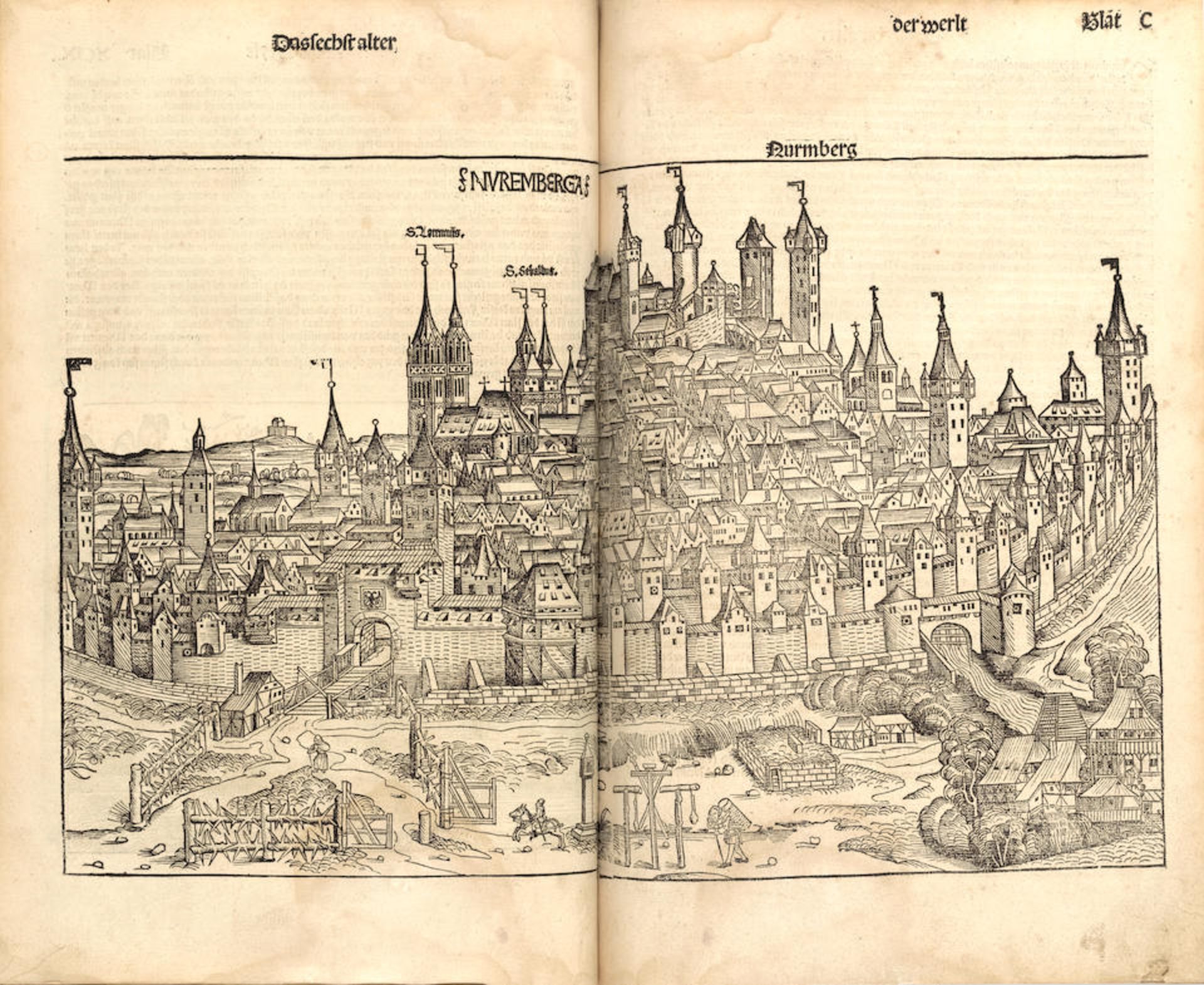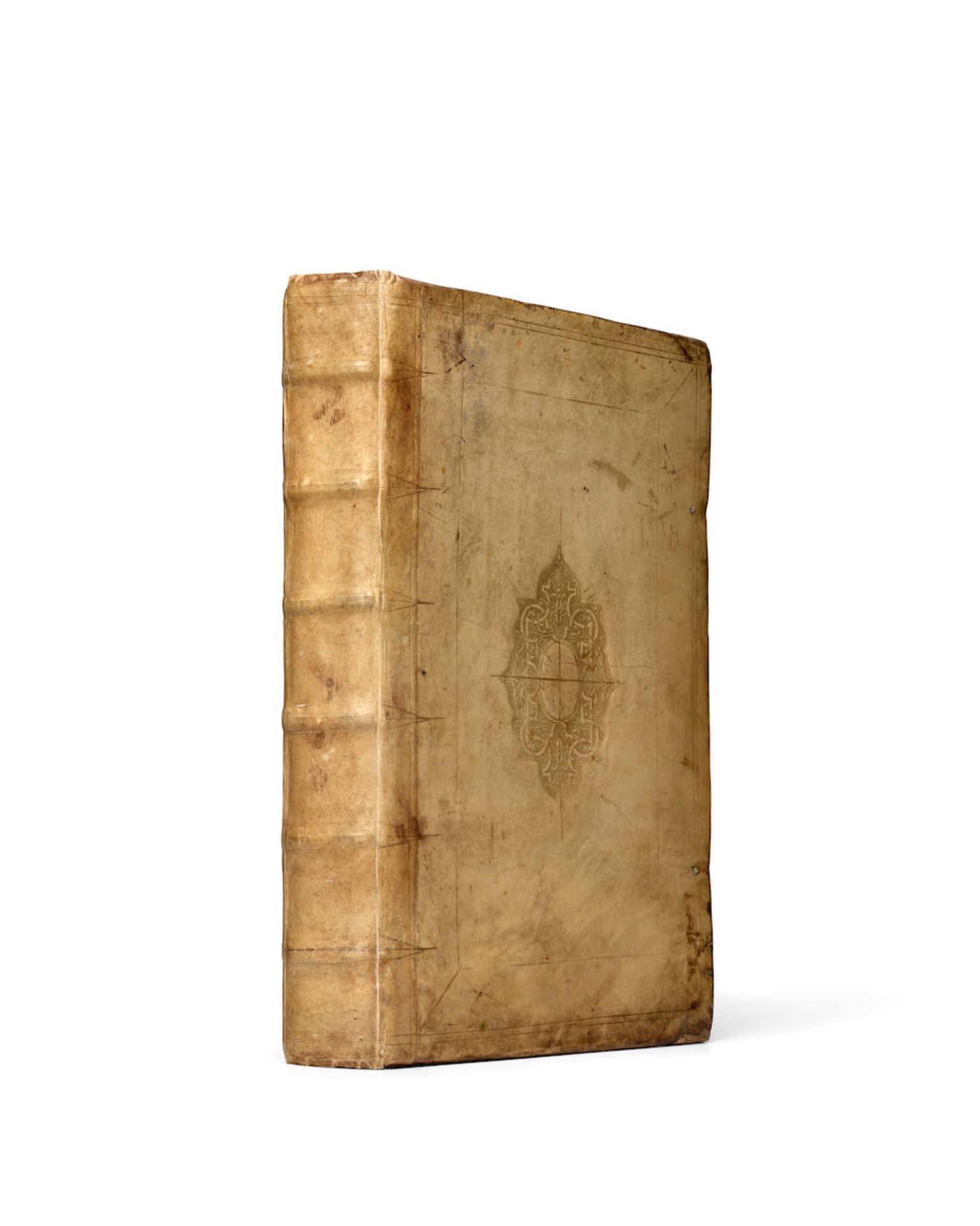11
NUREMBERG CHRONICLE. SCHEDEL, HARTMANN. 1440-1514. Liber chronicarum. [in German: Das Buch der ...
NUREMBERG CHRONICLE. SCHEDEL, HARTMANN. 1440-1514. Liber chronicarum. [in German: Das Buch der Croniken und Geschichten.] Nuremberg: Anton Koberger for Sebald Schreyer and Sebastian Kammermeister, 23 December 1493. Imperial folio (427 x 290 mm). 297 leaves (of 298, without final blank). 59-64 lines and headline, table and parts of the text in two columns. Types: 24:111G (text), 9:165G (headlines), xylographic title and c. 1809 woodcut illustrations printed from 645 blocks by Michael Wolgemut, Wilhelm Pleydenwurff and their workshop, including Albrecht Dürer, comprising 29 double-page town views, 8 full-page woodcuts and double-page maps of the World [Shirley 19] and of Europe by Hieronymus Münzer after Nicolas Khrypffs. 17th-century Dutch vellum stamped with large central arabesque, rebacked in style. Some browning and staining, xylographic title remargined and laid down, a few leaves with marginal repairs (including first index leaf) and large tear affecting image to leaf 268, about 30 leaves with short marginal tears or minor worming, leaf 188 with a few words in three lines erased. Provenance: A few leaves with early ink marginalia. FIRST EDITION IN GERMAN of the Nuremberg Chronicle, printed in the same year as the Latin edition. The German and Latin editions were planned simultaneously, with the German edition of Georg Alt's translation appearing five months after the Latin edition. The of the most extensively illustrated book of the 15th century. The 29 large double-page city views, many illustrated for the first time, are accurate in depicting distinguished features of each city. In addition, it includes many details of 15th-century daily life: carpenters with their tools, astronomers and their instruments, a chess player, archers, bridges, derricks, dishes, furniture, windmills, ships, beds, houses, fortifications, weapons, tents, wharves, ferries, books, drawing materials, dogs, horses, and other animals, as well as costumes. Hartmann Schedel's Nuremberg Chronicle epitomizes 'the commercial sophistication, economic power and technical virtuosity that brought the art of print to this extraordinary climax' (Pettegree). Reference: BMC II 437; BSB-Ink. S-197; Bod-Inc. S-110; Goff S-309; GW M40796; HC *14510; Pettegree, The Book in the Renaissance, New Haven, 2011 p 42; Reske, The Production of Schedel's Nuremberg Chronicle Wiesbaden, 2000; Ellen Shaffer The Nuremberg Chronicle, Los Angeles, 1950; Wilson, The Making of the Nuremberg Chronicle Amsterdam, 1976. For further information on this lot please visit Bonhams.com For further information about this lot please visit the lot listing
NUREMBERG CHRONICLE. SCHEDEL, HARTMANN. 1440-1514. Liber chronicarum. [in German: Das Buch der Croniken und Geschichten.] Nuremberg: Anton Koberger for Sebald Schreyer and Sebastian Kammermeister, 23 December 1493. Imperial folio (427 x 290 mm). 297 leaves (of 298, without final blank). 59-64 lines and headline, table and parts of the text in two columns. Types: 24:111G (text), 9:165G (headlines), xylographic title and c. 1809 woodcut illustrations printed from 645 blocks by Michael Wolgemut, Wilhelm Pleydenwurff and their workshop, including Albrecht Dürer, comprising 29 double-page town views, 8 full-page woodcuts and double-page maps of the World [Shirley 19] and of Europe by Hieronymus Münzer after Nicolas Khrypffs. 17th-century Dutch vellum stamped with large central arabesque, rebacked in style. Some browning and staining, xylographic title remargined and laid down, a few leaves with marginal repairs (including first index leaf) and large tear affecting image to leaf 268, about 30 leaves with short marginal tears or minor worming, leaf 188 with a few words in three lines erased. Provenance: A few leaves with early ink marginalia. FIRST EDITION IN GERMAN of the Nuremberg Chronicle, printed in the same year as the Latin edition. The German and Latin editions were planned simultaneously, with the German edition of Georg Alt's translation appearing five months after the Latin edition. The of the most extensively illustrated book of the 15th century. The 29 large double-page city views, many illustrated for the first time, are accurate in depicting distinguished features of each city. In addition, it includes many details of 15th-century daily life: carpenters with their tools, astronomers and their instruments, a chess player, archers, bridges, derricks, dishes, furniture, windmills, ships, beds, houses, fortifications, weapons, tents, wharves, ferries, books, drawing materials, dogs, horses, and other animals, as well as costumes. Hartmann Schedel's Nuremberg Chronicle epitomizes 'the commercial sophistication, economic power and technical virtuosity that brought the art of print to this extraordinary climax' (Pettegree). Reference: BMC II 437; BSB-Ink. S-197; Bod-Inc. S-110; Goff S-309; GW M40796; HC *14510; Pettegree, The Book in the Renaissance, New Haven, 2011 p 42; Reske, The Production of Schedel's Nuremberg Chronicle Wiesbaden, 2000; Ellen Shaffer The Nuremberg Chronicle, Los Angeles, 1950; Wilson, The Making of the Nuremberg Chronicle Amsterdam, 1976. For further information on this lot please visit Bonhams.com For further information about this lot please visit the lot listing










